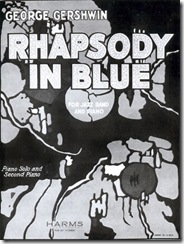 In the 1920s, if New Zealand newspapers reviewed records they were usually opera, classical or the light classics. I'm surprised the New Zealand Herald covered Gershwin's Rhapsody in Blue at all, so can forgive the reviewer for hedging his bets:
In the 1920s, if New Zealand newspapers reviewed records they were usually opera, classical or the light classics. I'm surprised the New Zealand Herald covered Gershwin's Rhapsody in Blue at all, so can forgive the reviewer for hedging his bets: Gershwin's Rhapsody in Blue is almost a new art form - a sort of symphonic jazz. Stravinsky and some of the French "six" have attempted something of the kind; but their compositions are far too self-conscious to be successful, and their knowledge of the peculiar kind of scoring needed, inadequate. The medium is of far greater interest than Mr Gershwin's music, which is extremely derivative. Rimsky-Korsakoff is drawn upon in the opening section, Debussy and Grieg toward the end. There are also many pure and captandum* effects. But something undoubtedly individual emerges. The composer plays the piano brilliantly; the whole thing has the air of an improvisation. The saxophones would prove useful as ordinary members of the orchestra. The tenor instrument is very similar in tone to a clarinet, only more supple; the baritone to a cello, but full and rounder. However, the orchestra of the future will perhaps be no settled body. Instead, we shall have chamber orchestras of varying content. This example may well be a portent. It is well recorded and of peculiar interest.- New Zealand Herald, 24 July 1926. * captandum: 'a specious argument "for capturing" the gullibility of the naive among the listeners"
Here is what the New York Times' reviewer said of Rhapsody in Blue the day after its premiere, performed by Gershwin at the piano, with Paul Whiteman and his Orchestra on 12 February 1924:
This composition shows extraordinary talent, as it shows a young composer with aims that go far beyond those of his ilk, struggling with a form of which he is far from being master ... His first theme ...is no mere dance-tune ... it is an idea, or several ideas, correlated and combined in varying and contrasting rhythms that immediately intrigue the listener. The second theme is more after the manner of some of Mr Gershwin's colleagues. Tuttis are too long, cadenzas are too long, the peroration at the end loses a large measure of the wildness and magnificence it could easily have had if it were more broadly prepared, and, for all that, the audience was stirred and many a hardened concertgoer excited with the sensation of a new talent finding its voice ... There was tumultuous applause for Gershwin's composition. [the edits are Wikipedia's]
Right-click to hear Gershwin performing it with an orchestra or, for better audio, on a piano roll. Above right: an advertisement for Whiteman's records from the New Zealand Herald in September 1928.




No comments:
Post a Comment